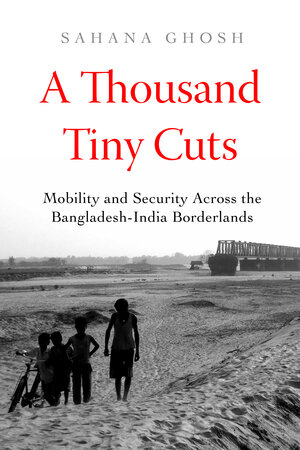by Sahana Ghosh, author of A Thousand Tiny Cuts: Mobility and Security Across the Bangladesh-India Borderlands
Borders and bordering in South Asia continue to be a hot topic. India and China are currently at an impasse over territorial disputes along its shared border, on the brink of military engagement. Pakistan and India have been engaged in multiple wars and military skirmishes across their hostile border since the partition of 1947, with their respective borderlands heavily militarized. Bangladesh is bringing its border and borderlands with Myanmar under greater surveillance and policing, transforming the mobility of Rohingyas fleeing genocide into a national security concern. These headlines jump out at us!
Across the world, militarized borders and the plight of clandestine border-crossers have come to dominate our imagination of the violence of bordering. Against this political landscape, India and Bangladesh officially insist that its shared border, the fifth longest land-border in the world, is “friendly” and all is stable and settled. This official line couldn’t be further from the realities lived in the borderlands: India has built a fence along its side of border, steadily militarizing its eastern borderlands since the late 1980s, and fatal shootings and injuries of clandestine border-crossers and suspected smugglers at the hands of state security forces continue. Yet, this is only the proverbial tip of the iceberg, the most visible form of violent bordering. Images of border fences and humans, cows, and drugs crossing them clandestinely offer the South Asian version of what has become a global template, though it is based on Euro-American borders.
How do people who live in borderlands experience and analyze the changing life of the border? In my recently published book, A Thousand Tiny Cuts: Mobility and Security Across the Bangladesh-India borderlands, I argue that bordering in this part of South Asia is ongoing, seven decades after the international border was first drawn in 1947 with the Partition of the subcontinent at the end of British colonial rule. It is not ongoing because there are territorial disputes or occupations to settle. Bordering is ongoing as a process of remaking identities, spaces, communities, imaginaries, and most importantly relationships: in terms of national security. These terms of national security, in the India-Bangladesh borderlands, operate through gendered devaluations: of land, of crops, of men and women as brides and grooms, of labor and wages, of migration histories, and among intimate kin in transnational families. Chapters of the book describe the different domains in which borderland residents negotiate what such bordering means to their everyday lives, making decisions of livelihood, kinship, mobility in relation to emergent ideas of national security.
Our attention – globally – is often fixated on the spectacular structures of border fences and floodlights or stories of border-crossing “illegal migrants” meant to shock. In moving our attention away from these forms of spectacular violence, this book tells the story of spaces being formed – or deformed – as borderlands, of peoples negotiating the costs of living in borderlands that are increasingly reshaped through the militarized lens of national security. The claim to friendliness hides the many forms of militarized bordering scattered across the borderlands, beyond headlines and geopolitical events. A particular story of an all-too common global condition.
The following passage is an excerpt from the Introduction of A Thousand Tiny Cuts: Mobility and Security Across the Bangladesh-India Borderlands:
Taar-kaanta, kaanta-taar, try saying it out aloud. It trips you up, inside your mouth.
In Bengali, the language in use on both sides in this region, India’s border fence is referred to as taar-kaanta (literally, barbed wire). Yet the term and object have come loose from the steel fence and is distributed in a way that exceeds the visual repertoire and vocabulary we have for the enclosures and intrusions that militarization brings to the agrarian ordinary. On walks in Indian border villages, my companions pointed out concertina wire by the side of the road where goats used to graze; in Bangladeshi border villages, farmers complain that the glare of the halogen lights illuminating India’s fence all night attract insects that damage their banana gardens. The direction of the lights is fixed in one way, leaving little room for imagining common cause or solidarity. Borderland residents on both the Indian and Bangladeshi sides used the Bengali phrase taar kaanta to refer to the physical border fence. However, they use the English word border to refer to the larger visible and invisible structure, including the unfenced parts, security practices, and historical conditions, such as “this border was open”; “the border is very heated these days”, and so on.
A Thousand Tiny Cuts tries to capture this interrelated sense of bordering: as a tense in the present continuous, a profoundly gendered relationship of power, and an embodied experience of mobility produced historically across multiple domains of life. The descriptions I offer attempt to ethnographically theorize a complicated matrix of militarized bordering—the material infrastructures, a gendered geography, the social relations, the political economic categories—that exceeds the visuality of the fence or the acts of physical violence that have come to dominate our understandings of border architectures and clandestine migrant trails, predominantly from Euro-American cases. To narrate how people navigate and live with the violence and injustices of bordering is to reach beyond a victimhood/resistance binary for agrarian residents of northern Bengal, predominantly Bengali Muslim and Rajbangsi.

